Engagement Efforts
Your guide for determining which efforts to use to maximize the effectiveness of your engagement fundraising system.

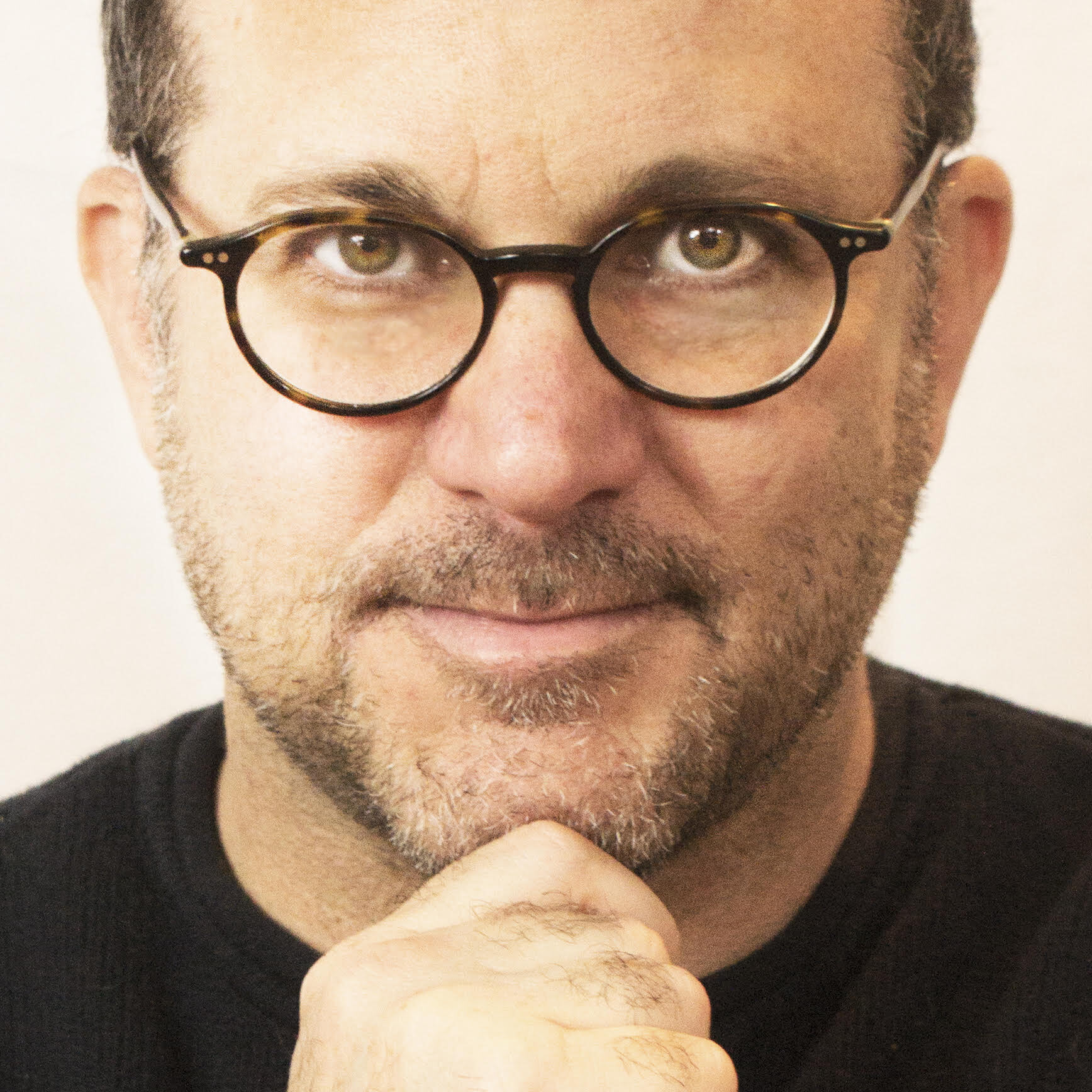
“There’s power in novelty.”
Humans love novelty.
That’s why car manufacturers often update their models, Apple releases updated product enhancements every few months, and McDonald’s brings back the McRib sandwich whenever pork prices drop deep enough to ensure profitability.
Providing novelty in the offers you deliver to your supporters can be an exceptionally effective way to draw forth their engagement and help them move themselves through the consideration process.
With novelty, we’re talking about bringing something new into the mix of your offers for engagement to attract attention and to ensure that people become less worn out by repetitive messages.
People are naturally drawn to opportunities to acquire new information or become involved in fresh, new experiences because it makes them feel good. Proof was provided in 2006 by researchers at University College London. They found that novel information and experiences trigger the release of dopamine—the feel-good chemicals—making us feel like there might be a reward waiting just around the corner. Their research suggests that we apparently anticipate positivity in association with novel offers.
They also found that novelty improves memory.
By combining novel, new information with familiar information during learning sessions, their subjects’ memories of the familiar were boosted by 19 percent. In other words, providing your supporters with new information or new ways of engaging with familiar concepts helps them retain an understanding of your organization’s mission, need, and how they can make an impact.
So, if you want people to engage with you more and remember what your organization can do on behalf of donors like them (who want to make an impact), make sure your offers are novel.
“There’s power in novelty.” Don’t ask for money (yet), ask for engagement.
Engagement Fundraising is not transactional.
It’s not about taking someone from the starting line to the finish line in one episode. It’s about giving people a low hurdle to overcome in order to get involved and move themselves forward at their own pace.
Novel offers invite supporters to engage or respond in ways that do not require much significant or careful consideration.
They work because they lower expectations, making donors and supporters feel safe — with no pressure to give money now. All that’s offered to them is value. You give and they get. They don’t have to give anything in return.
Your offers need to provide a reason for your donors and supporters to engage with your mission in a way that provides value for them..
We developed this menu of Engagement Efforts to help you decide which ones might be right for you. Of course, your Customer Success Manager has been trained to help you select and deploy the best offers for your needs.
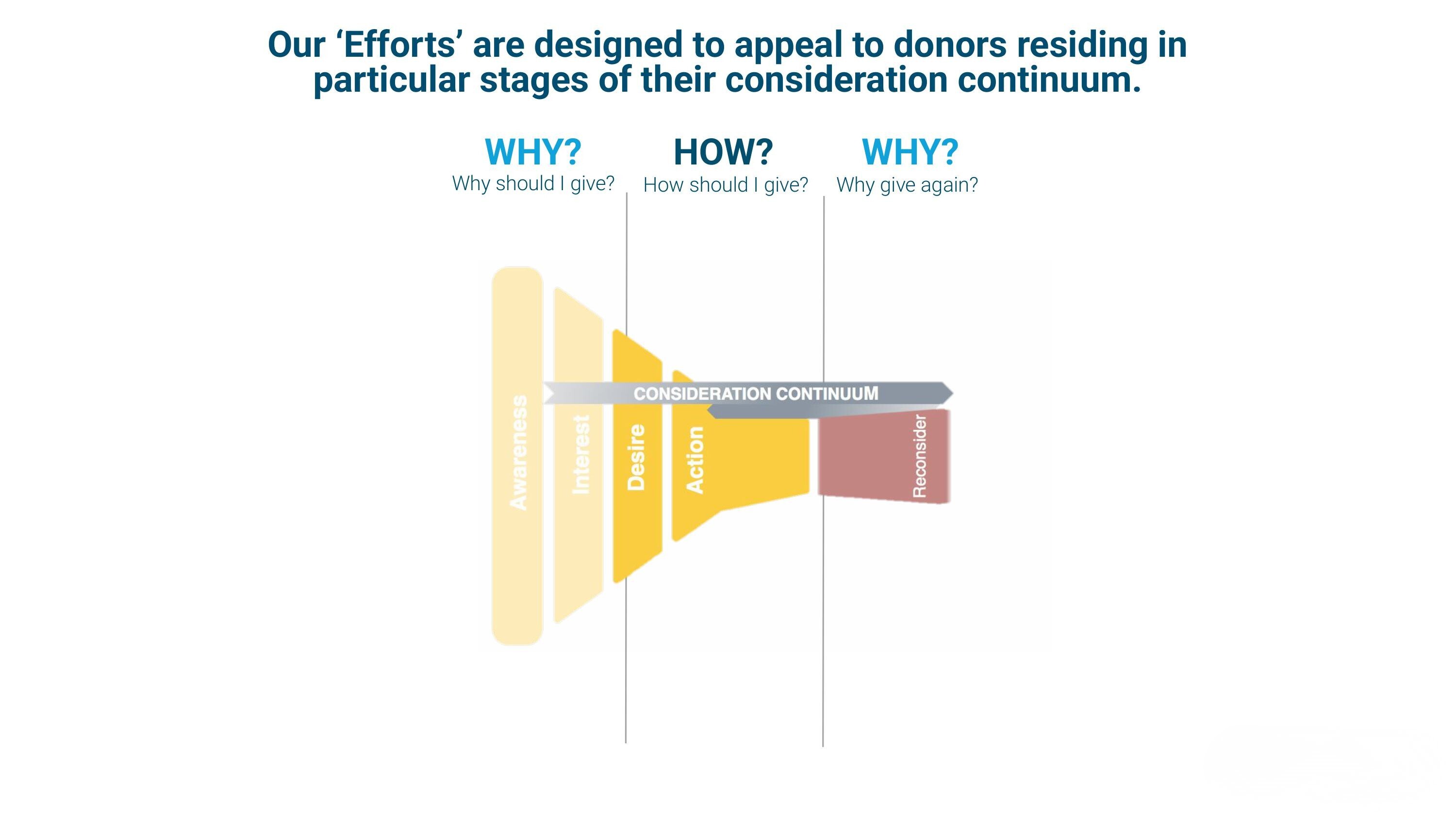

Inspire Nostalgia To Motivate Charitable Intentions
When a supporter shares a story about their unique experience, they deepen their relationship, connection and commitment to your organization or institution.
Our Tell Your Story Effort works because it offers supporters an opportunity to think about their lives and how their story intersects with your cause.
It gives supporters an opportunity to share their stories and read stories from others about their connections to your mission. It does this by driving traffic from email and social media (and possibly print) to a dual-purpose landing page that both asks visitors to share their stories and provides a place to display submitted stories from others in an engaging way.
It also evokes nostalgia, a powerful motivator in charitable giving. Nostalgia is a very personal, social emotion that involves momentous life events and social bonds—and charitable giving is a very personal, social behavior.


Inspiring nostalgia among supporters increases charitable intentions because it puts supporters in an ideal frame of mind to consider their philanthropy.
At the same time, this engagement fundraising effort helps gift officers collect valuable information from which to start a more meaningful initial conversation.

Dr. Russell James, J.D., Ph.D., CFP
World-renowned researcher, author, professor and expert in the field of charitable giving

“Fundraisers must help supporters recount:
What’s my autobiography? And, how does your mission align with mine?”
Benefits:
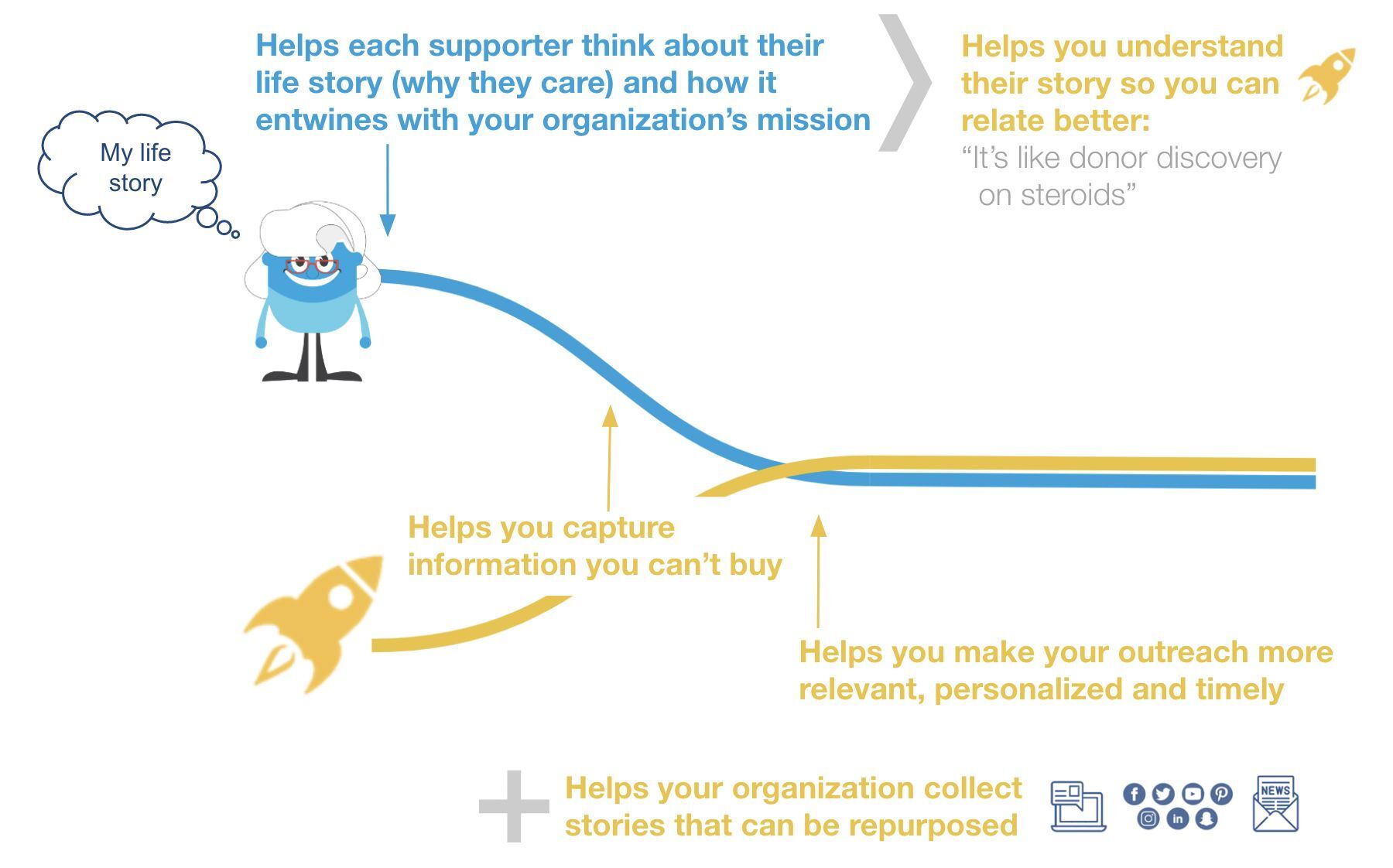
Cultivate & Steward Your Supporters & Donors
People inherently want to feel a sense of belonging.
They want to feel like they are part of a community or tribe.
Research has found that a sense of belonging helps give meaning to our lives, which can positively affect our wellbeing in ways that drive generosity.
A properly developed digital newsletter can foster this sense of belonging and community. And, when done right, it can steward current supporters so they feel they are part of a tribe of like-minded individuals.
Plus, a Digital Newsletter can save you money! Since printing, mailing and postage costs keep increasing, now is the time to help more of your supporters migrate online—especially since your oldest supporters are online too (thanks to the pandemic and Zoom!).


Benefits
- Create an insider experience.
- Generate awareness about giving opportunities.
- Steward supporters by engaging them with mission impact and supporter stories.
- Inspire existing donors to give again and possibly increase their giving.
- Offer free resources to help supporters volunteer or donate assets.
- Uncover supporters’ interests by monitoring their digital body language.
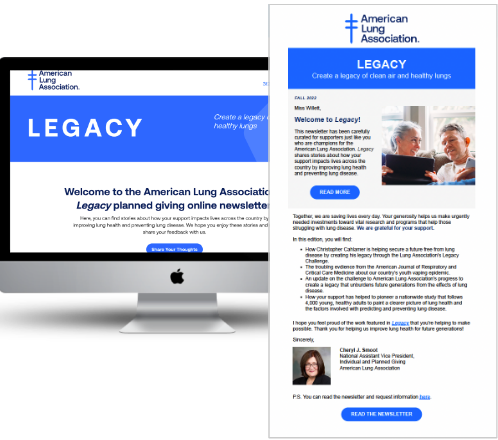
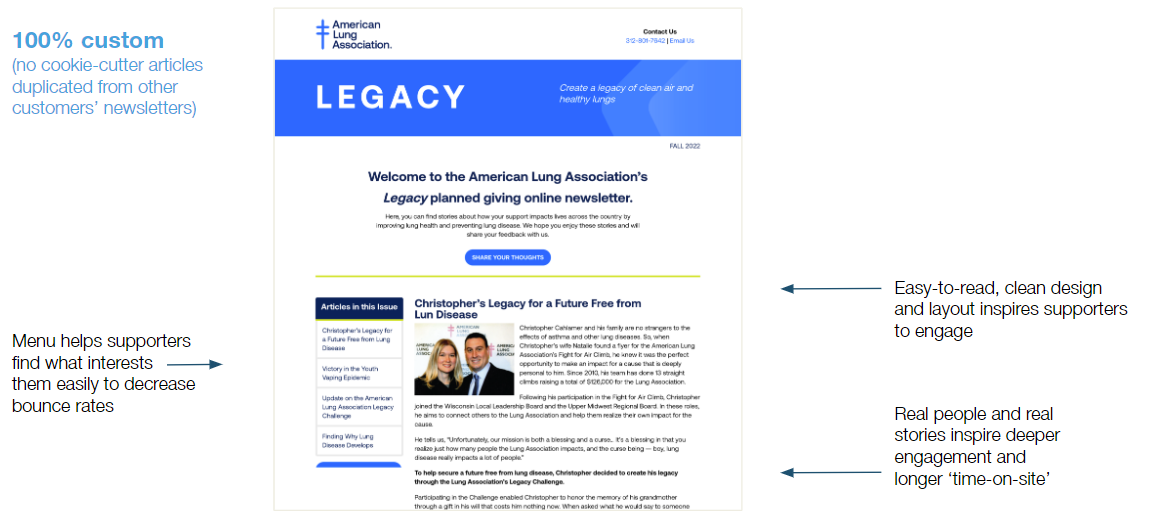
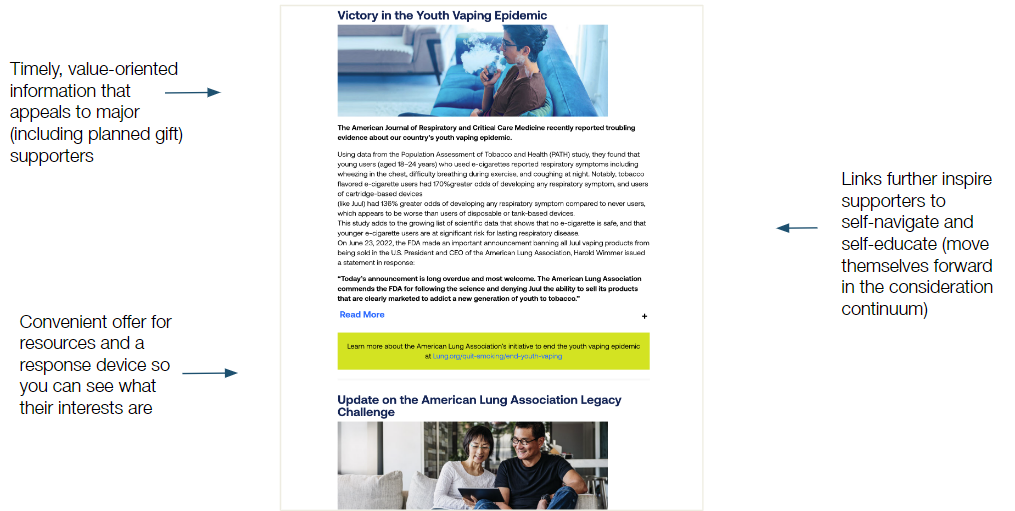

Land More Meetings With Highly Qualified Donors
“It is a plain fact of fundraising that it’s often far more difficult to get an appointment than to get the gift.”
- Jerold Panas, author of Mega Gifts
The Door Opener Effort quite literally opens doors to conversations for you. It is a high level automated workflow that includes an email invitation for supporters to arrange meetings with your staff. It employs a tested email/meeting invitation, a mini-questionnaire that gathers information regarding what each supporter wants to discuss, and drives supporters back to the meeting scheduling effort of your choice.
Your supporters will appreciate that you made such an offer in such a conscientious way.


This powerful, novel effort:
- Makes it easy for your top supporters, who are in the “how” stage of their giving consideration, to schedule an appointment with a fundraiser
- Allows them the opportunity to guide the conversation and provide more information about their goals for the meeting.
- Gives them the chance to choose how they want the organization to engage with them in the future.
- Helps to land meetings with highly qualified donors and prospects who are ready to meet.
- Eliminates the time spent on time-consuming and fairly meaningless back-and-forth communications traditionally experienced while setting meetings.
- Captures each supporters’ major gift interests so your staff understands them before the meeting (assuming you combine this novel fundraising automation effort with a brief questionnaire).
- Puts donors and prospects in a mindset to talk seriously about how they might make an impact.

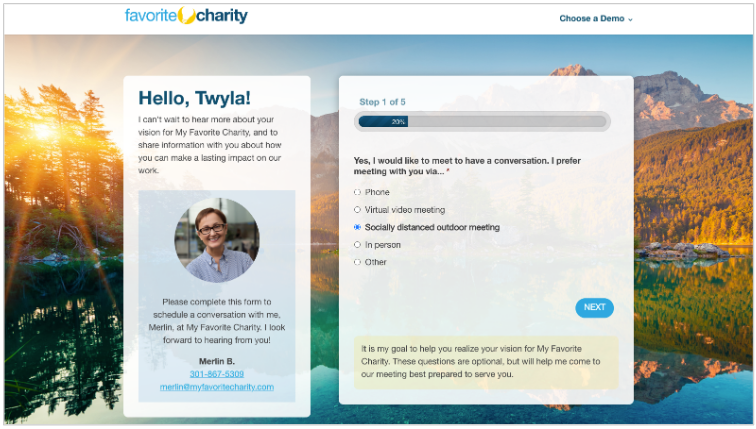
Generate More Major & Legacy Gifts From IRAs
One third of American households own individual retirement accounts (IRAs), and 31% of the $8.4 trillion saved in retirement assets in the U.S. is held in IRAs.
Once an IRA account owner reaches 73 years old, they must begin withdrawing funds—known as the Required Minimum Distribution (RMD)—from their account every tax year. However, most people don’t know they can make a Qualified Charitable Distribution (QCD) starting at the age of 70 ½. At age 73, they can make a QCD to satisfy their RMD while gaining tax benefits, avoiding IRS penalties, and making a greater impact than they ever imagined possible.
IRA holders who are at least 70 ½ years old but not yet 73 are not legally required to take RMDs. However, this group of people is still eligible to make a QCD, and may find tax benefits in doing so.
However, many supporters are not aware that they can use their IRA to support their favorite charity, or

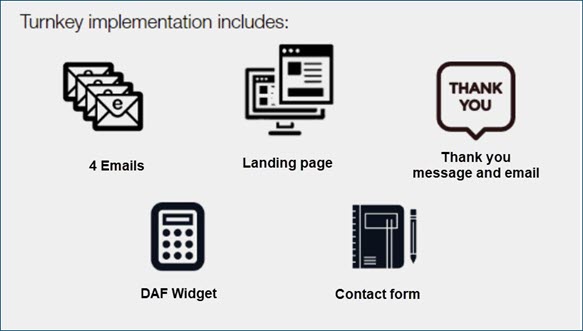
that they may satisfy their RMD with a qualified charitable distribution (if they are at the eligible age). Those who are 73 and older may find calculating RMDs confusing, possibly leading them to assume that giving IRA funds to charity via QCD might be confusing, too.
And finally, financial institutions (custodians) do not always make it easy or convenient for IRA holders to transfer the funds to charity, and most CPAs/advisors tend to calculate RMDs for their clients without recommending QCDs.
As a result, MarketSmart determined that there should be a much better (and easier!) way for supporters to make qualified charitable distribution gifts. So we created one! And you can too.
The QCD Effort aims to educate supporters in the WHY stage of this type of consideration, while also helping supporters in the HOW stage so they can quickly select their IRA custodian and receive an IRA distribution form that is automatically pre-filled with their name and contact information.
Our IRA QCD removes friction from the philanthropic giving process. The QCD makes it easier and more convenient for people to give so your organization gets:
- More major gifts now, as well as legacy gift leads
- More legacy gifts by beneficiary designation
- Habitual QCD giving
- A gateway to larger major gifts during the supporters’ lifetime, or a bequest (assuming the fundraisers build relationships with QCD donors)

Grow Your Legacy Society
Several companies now offer online efforts to help create wills or trusts more quickly and easily.
Each of them include a question that asks users whether they want to set aside a gift to charity after their lifetime.
However, some make money by charging the end users while others charge nonprofits for a chance to customize the effort so the users get asked whether they would like to leave a legacy gift to the sponsoring charity that paid to tailor the effort. Then the paying organization must market the offer. They need to promote the online will writing effort to their supporters, donors, staff & volunteers as a free gift.
However, unfortunately, most don’t have the budget to pay for such an arrangement. And the ones that can afford it don’t know how to manage that kind of marketing campaign effectively. Too often they simply promote the complimentary effort but fail to thank the new legacy donors in a timely fashion or stall before stewarding the relationships properly.


It doesn’t have to be that way. The Online Will Effort can help.
First and foremost, instead of taking a chunk out of your budget, it works by charging your donors instead. Plus, it’s turnkey—’done-for-you’ by your friends at MarketSmart. And finally, it automatically nurtures relationships by stewarding your new legacy society members properly—giving them the attention they deserve.
Also it encourages each new legacy society member to disclose more information about their gift(s) as it gently leads them to fill-out a gift notification page.
Plus, using a brief questionnaire opens the door for each new legacy society member to provide feedback and share information about why your mission is important to them. Then it inspires them to consider additional legacy gifts and major gift opportunities while offering them opportunities to provide feedback or arrange meetings, calls, or Zoom visits.
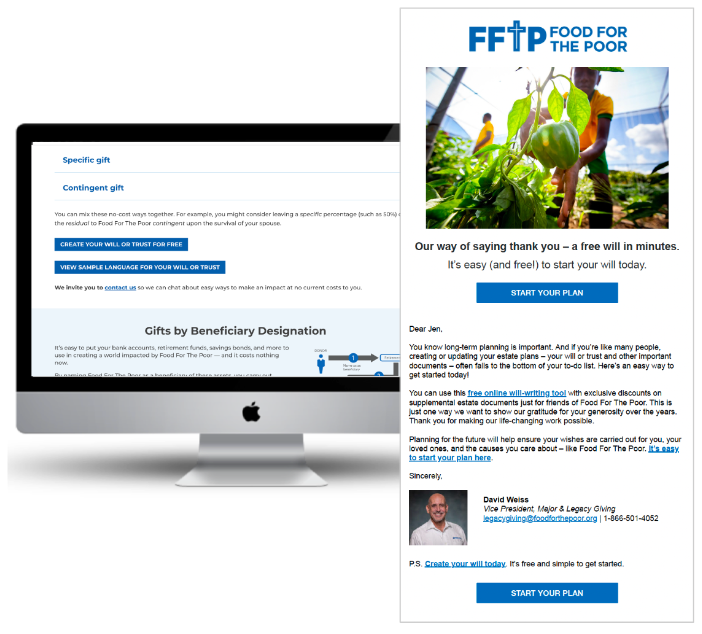
Uncover Hidden Legacy Gifts
Most of the time, when you try to engage supporters about legacy giving, they start to think about their own death.
Naturally, they do their best to avoid the conversation. However, we have found that assigning a deadline along with a non-death-related positive outcome helps facilitate the consideration of this type of gift. The Legacy Challenge employs this mixed-packaging approach by offering supporters the opportunity to activate a large, immediate donation in their name (thanks to a generous major gift sponsor) when they document a legacy gift within a certain period of time.
By packaging legacy gift documentation (an often-avoided task) with the positive outcome of a large immediate donation, the Legacy Challenge is a powerful combination of blended giving, social norms (otherwise known as the bandwagon effect) and urgency. This approach leads donors through the avoidance stage of the consideration continuum and incentivizes them to take action right away.


The time frame associated with the Challenge effectively becomes a deadline for their legacy-giving decisions.
Plus, once the Challenge goal has been met, it’s an excellent way to highlight the importance of legacy gifts to other supporters by featuring the Challenge participants who indicated they want to be recognized in a prominent way.
Featuring them with the Challenge sponsor really puts a “face to the name”— thereby normalizing legacy giving and inspiring others to consider a legacy gift commitment too.
The Legacy Challenge helps address something that holds people back from making a decision— the idea that they will not be able to see the impact of their legacy gift in their lifetime.
By participating in a Legacy Challenge , they can see and feel good about the present impact of their gift disclosure because there is an outright gift tied to their planned gift.

Generate More Major & Legacy Gifts From DAFs
DAFs hold tremendous potential for funding your cause, but how do you know which supporters have a DAF and who is interested in giving from one?
MarketSmart's comprehensive DAF * is the perfect way to maximize the potential of donor-advised funds. Our approach helps your supporters let you know they have a DAF and/or are interested in opening one at your organization. Then it automatically provides them with the information they need to make an impact.
One of the key reasons why this works so well is because it reminds DAF holders to utilize their DAFs to fulfill their philanthropic goals, since they often forget that they already put aside money for that purpose — “out of sight, out of mind.”


With this, the supporters who told you they have a DAF and automatically receive value-oriented, personalized reminders throughout the year to help them remember to use the DAF dollars they have already earmarked for charity.
The DAF Effort educates supporters in the WHY stage of this type of consideration, while also helping supporters in the HOW stage to quickly make a grant from their DAF, name your organization as a beneficiary of their DAF or set a meeting with your team.
With MarketSmart's DAF *, you'll be able to:
- Easily segment donors according to whether they have a DAF or not
- Re-engage supporters who have previously given via DAFs in the past
- Identify those who do not have a DAF and educate them about your organization's DAF offerings (Custodian Version), if you have one
- Provide resources for advisors as they advise their clients on making gifts
- Ensure donors keep your organization top of mind when considering their philanthropy and DAF giving throughout the year
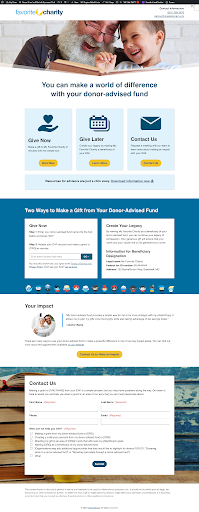
Fend Off Legacy Gift Leakage & Major Gift Lapses
Securing major gifts, mid-level gifts, and legacy gifts marks only the beginning of the fundraising journey, not the end.
For legacy gifts, most of which are revocable, the challenge is retention. Dr. Russell James notes, “Estates where a charitable component was always reported generated a disproportionately large share of the total charitable estate dollars (US) transferred.” In other words, early inclusion of a charitable component in estate plans often leads to larger gifts.
However, retention is precarious:
“Among decedents who had confirmed a planned bequest gift, 35% generated no estate gift,” with loss rates varying from 17% to 60% across organizations. Over a decade, only about 55% of charitable estate components remain intact among adults over 50, meaning nearly half of legacy commitments may never materialize.

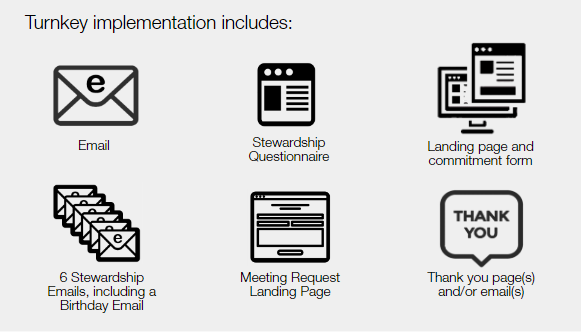
Mid-level and major gifts face similar challenges.
Without consistent engagement, the intent to give—whether through annual contributions, major gifts, or planned bequests—can fade, resulting in missed opportunities to increase gift amounts or inspire additional commitments.
Stewardship is the key to sustaining donor intent across all gift types.
The Stewardship Series offers a solution. Upon learning of a legacy gift, major gift, or mid-level commitment, this eight-month automated email program begins with a personalized questionnaire to understand each donor’s motivations, preferences for engagement, and vision for their gift’s impact. Tailored follow-ups nurture these relationships, ensuring donors remain connected to your cause and inspired to deepen their support over time.
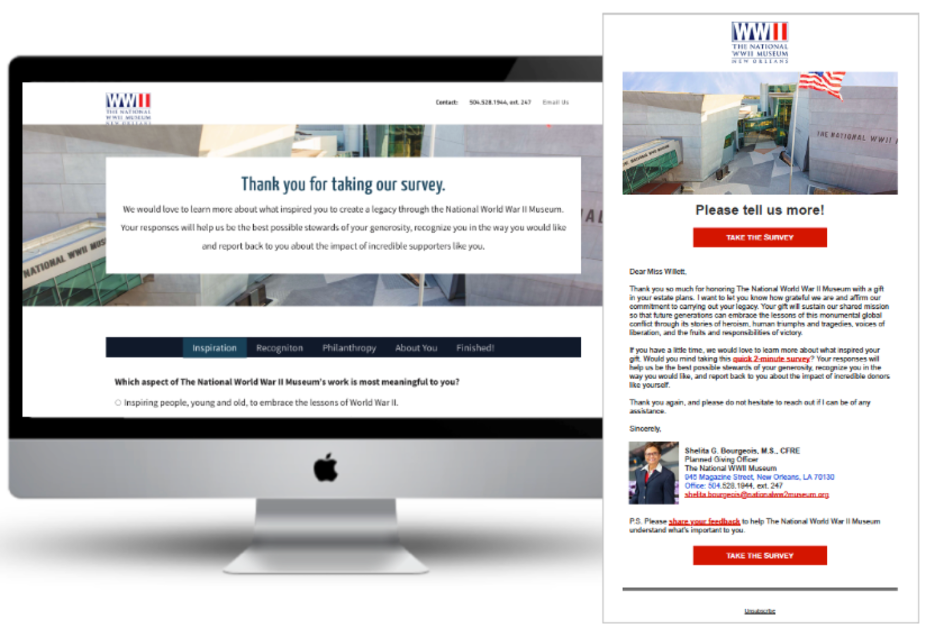
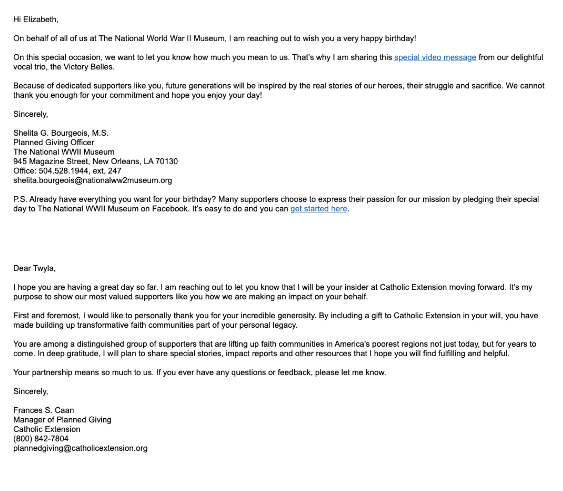

imarketsmart.com
Donor-driven major, mid-level and legacy
gift marketing guaranteed to deliver.